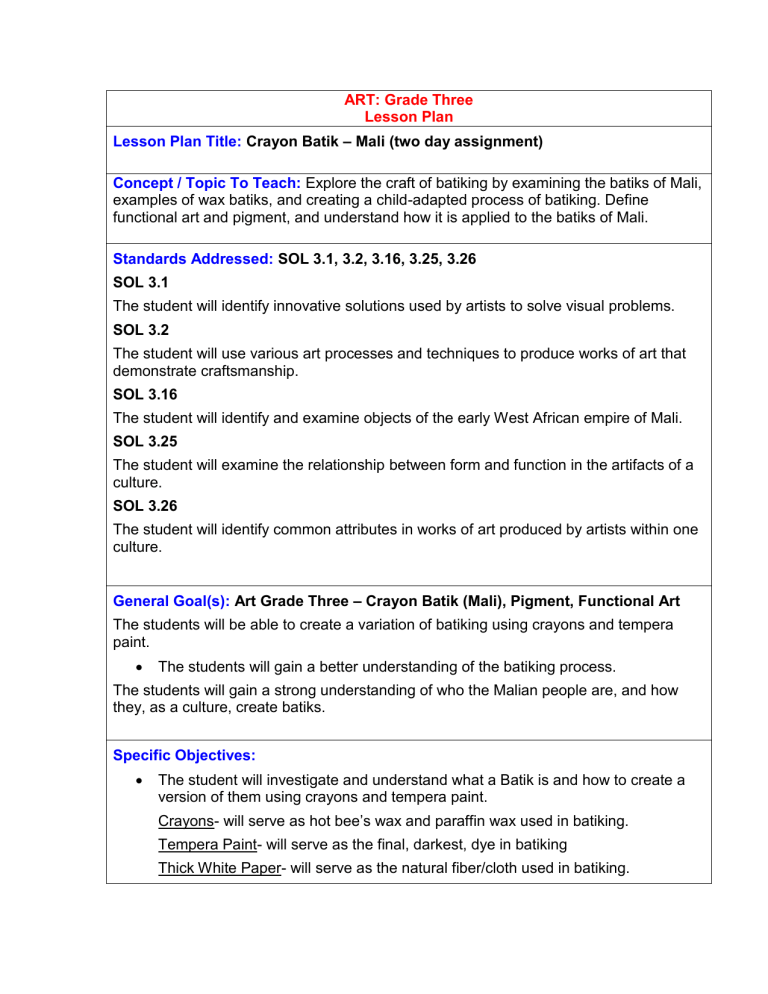
ART: Grade Three
Lesson Plan
Lesson Plan Title: Crayon Batik – Mali (two day assignment)
Concept / Topic To Teach: Explore the craft of batiking by examining the batiks of Mali,
examples of wax batiks, and creating a child-adapted process of batiking. Define
functional art and pigment, and understand how it is applied to the batiks of Mali.
Standards Addressed: SOL 3.1, 3.2, 3.16, 3.25, 3.26
SOL 3.1
The student will identify innovative solutions used by artists to solve visual problems.
SOL 3.2
The student will use various art processes and techniques to produce works of art that
demonstrate craftsmanship.
SOL 3.16
The student will identify and examine objects of the early West African empire of Mali.
SOL 3.25
The student will examine the relationship between form and function in the artifacts of a
culture.
SOL 3.26
The student will identify common attributes in works of art produced by artists within one
culture.
General Goal(s): Art Grade Three – Crayon Batik (Mali), Pigment, Functional Art
The students will be able to create a variation of batiking using crayons and tempera
paint.
The students will gain a better understanding of the batiking process.
The students will gain a strong understanding of who the Malian people are, and how
they, as a culture, create batiks.
Specific Objectives:
The student will investigate and understand what a Batik is and how to create a
version of them using crayons and tempera paint.
Crayons- will serve as hot bee’s wax and paraffin wax used in batiking.
Tempera Paint- will serve as the final, darkest, dye in batiking
Thick White Paper- will serve as the natural fiber/cloth used in batiking.
The student will be able to define pigment.
Pigment- finely ground, colored powders that are the coloring means in paint or
dye.
The student will be able to define functional art and give examples of Mali’s
functional uses for batiks.
Functional Art- works of art made to be used, instead of only enjoyed.
- Examples of Mali’s functional uses for batiks: clothing, household decorations
The student will discuss and understand why indigo, dark-brown, and white were
and are the primary colors present in Malian batiks.
The student will discuss and understand what traditional steps are in batik making.
Required Materials:
12x18” thick white paper
Instructional props (posters, images, etc.)
Teacher example(s)
Pencil
Crayons (in a variety of colors)
Glue (for mounting completed pieces to be displayed)
Various objects that could be traced (for creating a design)
Paper towels (for blotting off excess tempera paint)
Indigo colored tempera paint
Paint brushes
14x20” thick colored paper (for mounting completed pieces to be displayed)
Anticipatory Set (Lead-In):
Show an example of a “Crayon Batik” (teacher example)
Ask students questions to spark their interest such as:
1) What do you know about ancient Mali?
2) What do you know about batiks?
3) Can you tell me why indigo was a main color in Malian batiks?
Pass around a real wax batik made by the instructor.
Step-By-Step Procedures:
1. Complete all of the steps of the anticipatory set (above).
2. Distribute the materials needed to complete the assignment.
3. Have each student write their first name, last name, and art code on the back of
their 12x18” thick piece of paper.
4. Have each student draw a design, of their choice, on their thick 12x18” piece of
white paper.
5. Have the students color in their designs HEAVILY with light colored crayons.
6. Next, have the students ball up their drawings a few times (the more the drawings
are crumpled/balled up the more the indigo tempera paint will show through).
7. After the students have finished crumpling up their drawings, have them carefully
un-crumple/un-ball their drawings; smoothing them out as much as possible.
8. Next, have the students paint their entire drawing with indigo colored tempera
paint.
9. After all of the students have painted over their drawings have them remove the
excess tempera paint with paper towels (by gently dabbing).
10. Finally, have the students carefully carry their completed artwork over to the
drying rack.
Kinesthetic Learners: Have them experiment/practice the “batiking” process on
a separate sheet of paper. Have them complete the assignment.
Visual Learners: Show a completed “Crayon Batik” project and a real batik by the
instructor, in addition to photos of Malian batiks that demonstrates this
assignment’s objectives.
Plan For Independent Practice: Have the students practice the “batiking” process by
coloring heavily and lightly on a separate piece of paper, crumpling the paper (or not
crumpling the paper if they want to see what it would look like un-crumpled), and then
painting on top of the drawing with indigo colored tempera paint (blotting off the excess).
Closure (Reflect Anticipatory Set):
As a class, we will have a review. The review will consist of going over all of the
objectives of this assignment (batiking, the country and culture of Mali, functional
art, pigment).
Assessment Based On Objectives:
Examine the students’ “Crayon Batik”. I will be specifically looking for:
a) The use of crayons as a “dye resistant”
b) The use of indigo tempera paint as a “dying agent”
c) Craftsmanship (neatly depicted designs that demonstrate a clear understanding of
the assignment objectives)
d) Correctly labeled artwork (ability to follow directions)
Adaptations (For Students With Learning Disabilities):
Provide assistance in developing a design.
Make sure their assignment is correctly labeled (name, art code).
Demonstrate how to color heavily, allowing their drawing to be viewable
after the “dying” process.
Extensions (For Gifted Students): Allow the students to complete a second “Crayon
Batik” using a different subject (not a design) and different colors (colors not
predominate in Malian batiks).
Possible Connections To Other Subjects: Art History, Math/Geometry,
History/Geography
Notes:
